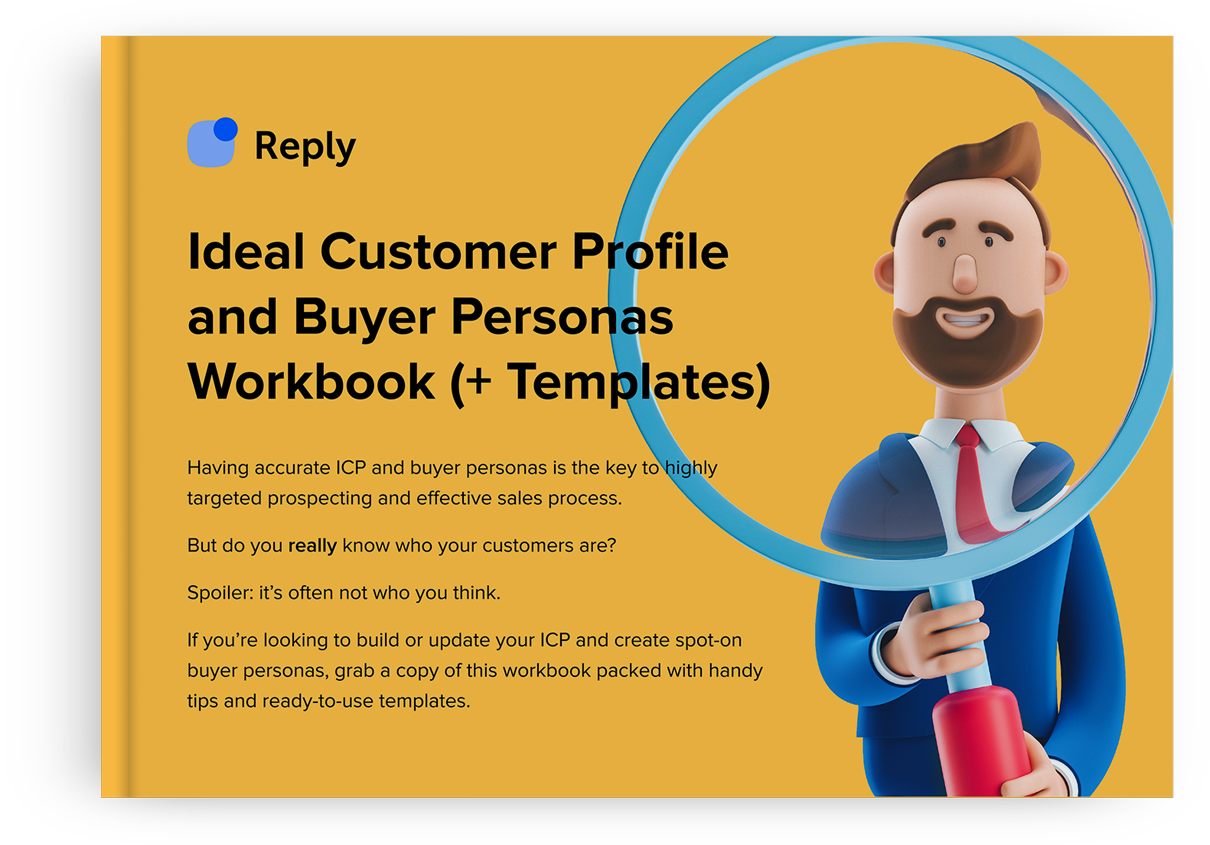When we’re talking about identifying an ideal customer profile and specifically having those customer development calls, whose responsibility it is?
Brad: Yeah, I mean, happy to chime in. I actually think Tim and I might have quite different answers for this, just because, obviously Tim’s the CEO, and I’m not. But happy to chime in with mine, and it might ruffle a few of Tim’s feathers. So no, I’m just I think, you know, in most businesses, probably it comes from the top down in terms of what the ICP is, who we’re trying to sell to.
I mean, I’m not saying this is necessarily the right way, but I think that’s quite often the case. I think, like most things, really, the ICP becomes whoever it is that seemingly wants to buy your solution, whoever has those problems. It’s a kind of natural thing to an extent. It’s almost the way I see it, it’s like the value of something is what someone’s willing to pay for it, rather than what someone values something at.
So I think that’s kind of my thought process on it a little bit. I think it’s the team effort, and I think the key is that constant feedback loop around, actually, this isn’t working, or we’re having this feedback when we speak to this type of person, and that’s how the ICP, I guess, develops.
But I’ll pass it over to Tim because I don’t know if he’s got a slightly different view on that.
Tim: Awesome. But just to add something to what Brad was saying and jokes aside, I think that especially in the early days, marketing is a long-term thing. It’s a midterm to long term.
You’re not going to get answers about your ICP and stuff with marketing. So everybody should start outreach outbound today. If you haven’t done outbound, start it now because you’re going to have the quickest answer to your messaging.
You’re going to have the quickest answer to, is this my ICP? No, f* off. And then you have so many of those, you’re like, that’s not my right. And you keep trying things. I think in sales, in three months, you are going to get answers. In marketing, it’s going to take you six to nine months to get just a little bit of an answer.
So I think the combination is Olivia, you were asking the question, and Brad, of course, in the size of HubSpot, I think it’s top-down, but in the size of my company, we all chime into that discussion. And I think this is why, if you do research a little bit about my past podcast and stuff that I was saying, I think that marketing and sales should disappear. We should all be growth we should all be a growth team. Right?
Because marketing will say, here’s an MQL, and then you’re like, well, yeah, that’s MQL. Okay. Is it an SQL? No, it’s not an SQL. This is wrong. It’s not closing. And then sales will say, well, marketing is bringing terrible leads. And then marketing will say, well, sales don’t know how to close deals.
And then I’ve seen this so many times, but when you put them in a room and you tell them to brainstorm together and work together for a month, and then they’re like they start loving each other, and then they start giving feedback to each other. And suddenly that ICP that messaging is across the board not perfect, because nothing is ever perfect, but it starts becoming really good.
Dipak: I think if I can just add some final thoughts there, just on that point, I think having that active feedback loop is absolutely imperative. So say, for instance, you’re working with Rev Ops to understand, collect, and analyze data on existing product usage. Having that sent over to marketing to make it understandable in a way that’s, again, easy for sales to digest, so they can make the adjustments that they can in their cadences and whatnot and kind of go from there.
So there is absolutely a need in terms of having everyone aligned and everyone on the same wavelength. So it is an absolute team effort.
What methods do you use to research and get data for creating and refining your ICPS?
Brad: I think this is a really interesting question. And I think the answer to this really, again, probably depends in terms of what type of business you’re in, how big the business is, and things like that. I think probably in a lot of bigger businesses, a lot of this content probably does come across from marketing or from enablement in the form of training, where it’s kind of very much, this is what you need to know, these are the challenges they’re facing, et cetera.
But I know a lot of people on this call today are going to work in probably smaller businesses where they might be the only SDR or one of two SDRs, and not a huge amount of kind of training above them. And I think there’s so many tools out there at the moment that kind of help you do that. I think it’s just a case of getting stuck.
You know, one example might be if, let’s say, for example, I’m just going to pick a random example that you’re focused on the telecommunications industry in the UK. Now, the first thing I would probably do if I started a job there is find loads of industry whitepapers, anything I could get free online I can download as a PDF, pay ChatGPT, whatever it is, for the slightly premium version.
Upload all of these PDFs and say, draw down what are the biggest challenges that these telecommunication companies are having. It sounds really simple and obvious, but it’s such an easy way of doing it and I find anything to make my life easier and that saves me time.
So that’s probably what I would do. And find out what those challenges are, gather data about the industry, really find out what’s going on, because that effectively, as Tim says, allows you to have the best conversations and that’s all sales is at the end of the day, is having a conversation and hoping that you kind of hit jackpot.
Tim: Really, Brad, I smiled when you said ChatGPT because I was hoping that somebody’s going to bring it up because all my webinars, I just speak about chat lately. That’s been my obsession for the last year. And come on, $20 a month for the advanced data analysis.
Now that Brad’s saying, upload your PDFs, upload your whole export of your CRM of close/lost, all of them. Just upload it and ask those questions and you will be mind blown. I did this on a webinar and people were mind blown. You can do that. And I didn’t even like I was just in it live. Just upload that CSV, that Excel sheet, whatever you have as an export, ask these questions and it’s going to really brainstorm from an angle that doesn’t have tunnel vision. We have tunnel vision.
We all have tunnel vision in our companies. In the first month, you start getting tunnel vision because you meet the CEO. It tells you the mission, vision, and values of the company. Okay, that’s it. And you suddenly are in that tunnel now. So ChatGPT really helps me get out of that tunnel vision. So I definitely recommend it to everybody.
But if I may and I know Deepak stopped me because I’ll speak for hours, but I think that there’s a combination of a few things and I’ll just tell them and I won’t get into them. But internal data, that’s what we’re saying with Brad. Upload it and get that survey and feedback 100%. Market research.
Don’t do just market research before you start your startup or whatever, keep doing market research. Because the market changes a lot, as we know. Social media and online communities — we don’t tap into this enough. And online communities are everywhere.
Reddit, if you’re a bit geeky or product or something like that, you want a good community, go to Reddit and say something wrong about that and see what’s going to happen. And then they’ll all attack you. And then you learn so much from it, it’s incredible.
I was just reading this. Somebody was saying they have two Reddit profiles. They have one, which is for themselves and positive stuff, and they have one, where they ask a question and then they go with the other one and they give a wrong answer. Because nobody wants to help people, but everybody wants to correct people.
And then you can have obviously like us, we do market research, we do lead research for you. We’ve done it for 500+ customers. So we know a little bit about the ins and outs of that. And then keep doing those interviews with your customers, tap into lookalike audiences, and see if that lookalike audience is working. If it’s working, that means you do have a good audience.
Look at your competitors, keep analyzing them, and many other things that I could add here. But I think that today almost ending 2023. We have AI. We have this amazing tool of AI. It can search the web, maybe not the free version, of course, and maybe the Bing search is not amazing, but there are many other tools out there. There are plugins. You can actually get those answers in minutes instead of months. Before we would give a project to someone and wait for months. Now we can actually get that almost in half an hour, you can get these answers.
Dipak: Tim, to your point, I think communities like Reddit have been incredibly powerful. People aren’t so worried about opening up, about their true state of affairs, or what’s taking place in their companies because again, they can remain truly anonymous and no one can trace it back to who they are. Versus, for example, on LinkedIn, where people might be a bit more apprehensive to say certain things because they know their colleagues and peers are constantly keeping an eye on their content and so on.
So there’s a wealth of information being shared in these communities that hasn’t really been tapped into by a lot of people. At Dealfront, again, shameless plug, since we offer a data enrichment and sales intelligence tool, we’ve been pretty much drinking our own champagne in that sense and combining that with a series of automations kind of to what Brad and Tim mentioned.
Again, having established a lead scoring model and then being able to better prioritize what leads should we dedicate more attention and focus on and then combining them with?
Tools like BuiltWith, for example, have been incredibly useful for us since we have a web visitor product and we can analyze and see what other tools or what other software have companies incorporated into their website and see where our lead feeder product can help complement those efforts.
And, for example, if we identify they’ve got the HubSpot plugin, we know that chances are they’re most likely using HubSpot as their CRM. And since we have a native integration with HubSpot, it kind of opens up the door for us to plug that in and yet becomes another avenue for a conversation starter too.
Tim: I love what Deepak said and I’m just going to go back to something you said, drinking our own champagne. I prefer it so much more than what my business partners and we say it’s eating our own dog food. So I’m going to change that to drinking our own champagne. That’s so much better. Thank you. Yeah, much sexier. I like it.
![Precision Prospecting: ICP Best Practices and Pitfalls [Webinar Transcript] Precision Prospecting: ICP Best Practices and Pitfalls [Webinar Transcript]](https://reply.io/wp-content/uploads/Baner-1080x567.jpg)




![Upselling and Cross-selling: The Go-To Guide [+7-Step Framework Inside] Upselling and Cross-selling: The Go-To Guide [+7-Step Framework Inside]](https://reply.io/wp-content/uploads/upsale-1024x538.jpg)
